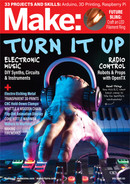
119
make.co
M
akers seem to like connecting things
together. Why is this? Of course, there’s the
convenience of remote control, which almost
everyone appreciates. But there’s something
strangely satisfying when previously unassociated
devices can interoperate in a synergistic whole —
the sum is greater than the parts.
This is what I’ve always liked about home
automation (HA) technologies, from the earliest
TV “clickers” to the latest innovations like Home
Assistant and Matter.
MY HOME AUTOMATION PATH
My family were early adopters of consumer elec-
tronics in the 1960s. Impressed by our Zenith TV’s
“Space Command” remote control, I took it apart
and learned that it wasn’t electronic, but acoustic!
I soon discovered that shaking a bunch of keys
on a ring could also control the TV. Mom was not
amused. Dad tolerated my experimentation in
home automation security.
Thus began my HA journey. As an MIT student I
automated current-sensing coils and a phone line
to report the availability of washers and dryers
in the laundry room (Figure
A
). When I bought
my first home I installed X10 switches, outlets,
and controllers. And when I got my first home
PC, I bought an X10-to-serial interface so I could
create rules for those devices: Turn on the porch
light at sundown.
In the early 90s I worked for a company
creating prototypes for the new CEBus/EIA-
600 standard, intended to enable multi-vendor
home automation. Network layers included
powerline carrier (like X10) but also RF, infrared,
and coax. More importantly, CEBus included
reliable, secure communication and an extensible
language to accommodate all kinds of HA devices
for lighting, security, energy management, etc.
CEBus was widely adopted — but failed. What
was missing? Low-cost, small microcontrollers,
and wireless networking like Wi-Fi and Bluetooth.
IoT, Wi-Fi, BLUETOOTH, ZIGBEE, ZWAVE
By the 2000s, home Wi-Fi, internet, and
smartphones enabled a new generation of home
automation products accessible to a much
larger market. Wireless switches, plugs, and
outlets became easy to install and configure with
Xxxxxxxxxx
B
manufacturer’s apps on your phone, which then
control your devices through the manufacturer’s
cloud services. (Easy, as long as the Wi-Fi and
internet are operating perfectly.)
More products entered the market from
Amazon, Apple, Google, Samsung, Philips, and
many new vendors, adding more complexity
and automation possibilities. New networking
standards including Zigbee and Z-Wave enabled
mesh networks to connect devices throughout the
home, extending reach beyond Wi-Fi.
But competing standards made it challenging
to create an HA system with products from
different vendors. And proprietary protocols gave
do-it-yourself makers limited opportunities to
build their own devices that could work with a
vendor’s products. Sure, you could become an
Apple HomeKit or Google Home developer, but
this is not for the casual maker.
I gradually replaced my flaky X10 devices
with light switches and outlets based on Tuya
(tuya.com), an HA platform available to many
vendors; a Nest thermostat; and a water-leak
detection system from a discontinued Zigbee-
based platform, Eaton’s Home Heartbeat. My
son Michael and I built a Raspberry Pi solution to
integrate with Home Heartbeat, enabled by the
reverse engineering documented by Blooming
Labs makerspace (bloominglabs.org/index.php/
Eaton_Home_Heartbeat). Fun, but it still couldn’t
readily integrate new HA devices and services.
HOME ASSISTANT: OPEN SOURCE
TO THE RESCUE
During Covid, I stumbled onto the impressive
Home Assistant project (home-assistant.io):
“Open source home automation that puts local
control and privacy first. Powered by a worldwide
community of tinkerers and DIY enthusiasts.
A
A
d
o
b
e
S
t
o
c
k
-
t
o
m
a
s
k
n
o
p
p
M85_118-23_SB_HomeAuto_F1.indd 119M85_118-23_SB_HomeAuto_F1.indd 119 4/9/23 1:17 PM4/9/23 1:17 PM
..................Content has been hidden....................
You can't read the all page of ebook, please click here login for view all page.
